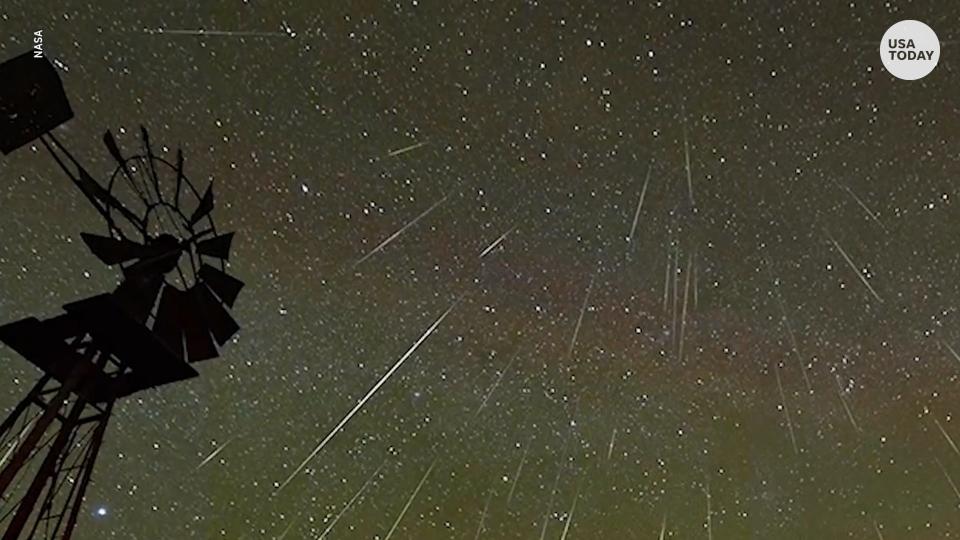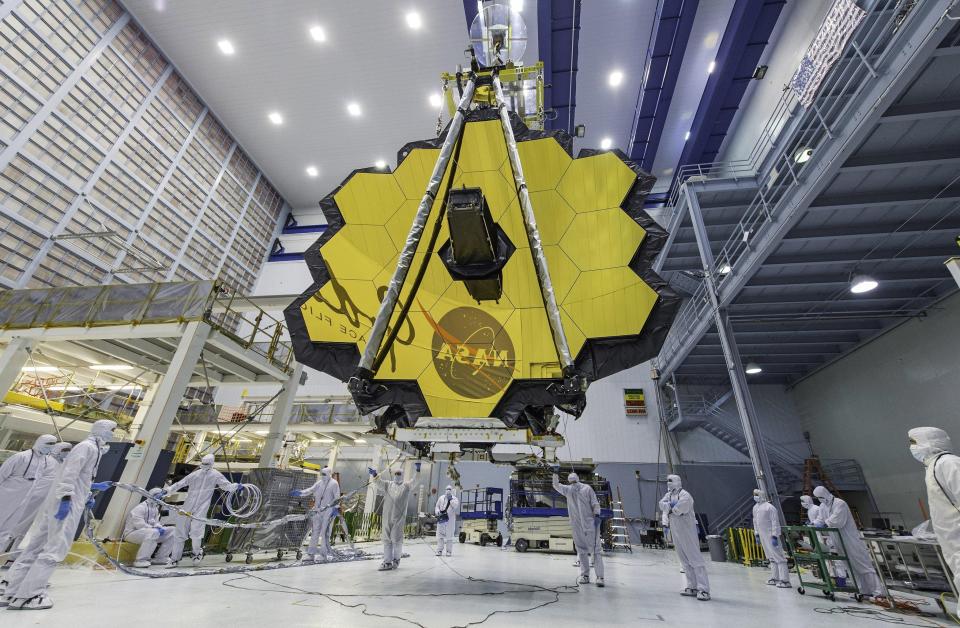Stelliferous: Geminid meteor shower, and the launch of the James Webb Space Telescope
Did you ever think about the fact that astronomy is a science that deals with what was rather than what is?
Seriously. Let’s say an astronomer trains a telescope tonight at the Andromeda Galaxy, the closest galaxy to our own Milky Way. The Andromeda Galaxy is 2.5 million light-years away, and a light-year is how far light travels in one year (5.87 trillion miles), so the light from the Andromeda Galaxy that our astronomer sees tonight left that galaxy 2.5 million years ago, about the time early hominids started using stone tools.
Even an astronomical event that happens in the present, such as a meteor shower, is a trip to the past.

Take the Geminid meteor shower, which reaches its peak the nights of Dec. 13 and 14.
Most meteor showers occur when the Earth plows through debris left by a comet. When those cometary bits and pieces, usually the size of a grain of rice, hit the atmosphere, they burn up and create what some people call falling or shooting stars. The parent of October’s Orionid meteor shower, for example, is the famous comet Halley.
The parent of the Geminids, however, is an asteroid called 3200 Phaethon. As it approaches the sun in its 1.7-year orbit around it, chunks of the asteroid break off to become the meteors of the Geminids as they rip through Earth’s atmosphere at 79,000 mph.
Producing up to 150 meteors per hour, including the occasional fireball, the Geminids were first recorded in 1833 – so meteors you see during this month’s shower might be from 3200 Phaethon’s first appearance in our part of the solar system, 188 years ago, or they might be from the asteroid’s most recent visit, in 2020. In any case, you’re looking into the past.
Meteor showers are named for the constellation from which they seem to radiate (it’s called the radiant), and, for the Geminids, that’s Gemini, which rises a little after 9 p.m. Nov. 13.
A waxing gibbous moon, 75% illuminated, will wash out meteors for much of the night, but it will set at 2:25 a.m. Dec. 14, while Gemini is still high in the sky, which means you’ll have good viewing until civil twilight at 6:47 a.m.
James Webb Space Telescope
Our final item involves a trip way back into the past — almost to the beginning of time.
On Dec. 18, the $10 billion James Webb Space Telescope, a collaboration between NASA, the European Space Agency and the Canadian Space Agency, will blast off aboard an Ariane 5 rocket from the Guiana Space Centre in Kourou, French Guiana, on a mission that will look more than 13 billion years into the past and allow us to see light created just after the big bang.
For anyone interested in astronomy, this is a very exciting mission, one that is expected to surpass even the accomplishments of the Hubble Space Telescope, which are many.
For more than 30 years, we’ve marveled at the mesmerizingly beautiful images Hubble has sent back to Earth and at the advances in our understanding of the universe the telescope has provided. Hubble has made more than 1.9 million observations, and its data have been the source of more than 18,000 scientific papers, which, themselves have been cited in almost 1 million other papers.
“The world’s most brilliant astronomers do miracles with this observatory,” said David Leckrone, former Hubble senior project scientist. “And it just keeps going on and on and on, and my jaw keeps dropping lower and lower with each new discovery.”
And, according to NASA scientist Michelle Thaller, “There’s not a single astronomer in the world whose life hasn’t been touched by Hubble.”

So, why such high expectations for the Webb Space Telescope?
Let’s compare the two telescopes.
Size: When it comes to reflecting telescopes, the bigger the mirror, the more light it gathers (in other words, the more it can “see”). Hubble’s mirror is 7 feet, 10½ inches. Webb’s mirror is 21 feet, 4 inches.
What Webb and Hubble see: While both telescopes operate in the visible spectrum (that is, they can photograph objects visible to humans), Webb will be able to see farther into the infrared portion of the spectrum than Hubble does. This is important because light from the most distant galaxies (those formed soon after the big bang) reaches Earth as infrared light, and the more infrared light a telescope can detect, the more distant galaxies it will see.
Location: We send telescopes to space so they don’t have to deal with manmade light pollution and the blurring effects of Earth’s atmosphere. Hubble orbits the Earth, at an altitude of 340 miles. Webb will not orbit the Earth; rather it will be at a fixed location called the second Lagrange point, or L2, 1 million miles from Earth.
A Lagrange point – there are five of them – is a place in space where the gravitational forces of two large bodies, such as the Earth and sun, cancel each other out, and an object, such as a telescope, can be parked there to make observations. Picture the Earth in its orbit around the sun; now, draw a straight line from the center of the sun through the center of the Earth, extending to a point 1 million miles past Earth. That is L2.
So, the Hubble telescope orbits the Earth, passing between the Earth and sun and between the Earth and moon, its observations affected by light from the sun, Earth and moon, but the Webb telescope will always be on the opposite side of the Earth from the sun, pointing its giant mirror out into the depths of space. Further, a polymer shield the size of a tennis court will block all light from the sun, Earth, and moon, insuring a constantly dark sky for the telescope to peer into.
It will take roughly 30 days for Webb to reach its orbit at L2, then, after six months of checkouts and calibrations, its science mission will begin.
We can only wonder what its first images will be.
Upcoming Events
Astronomy by the Bay: The Bishop will provide telescopes so you can observe the waxing gibbous moon and the planets Venus, Saturn and Jupiter, which will be lined up like a string of pearls along the ecliptic in the western sky. And, yes, we’re still looking into the past: Venus, the closest of our three planets, is almost 60 million miles from Earth right now; that’s more than five light minutes away, so the light you’ll see when you look at Venus left the planet five minutes before you see it. The event is free but registration is required. (Dec. 14, 5:30 p.m. to 7 p.m., The Bay Park, 777 N. Tamiami Trail, Sarasota)
How to Use Your Telescope: Need some help figuring out how to use your telescope? Meet us out at Robinson Preserve and we will help you figure it all out! Don’t forget to bring your telescope with you! The session is free but group size is limited and registration is required. (Dec. 18, 4:30-5:30 p.m., Robinson Preserve, 10299 9th Ave. NW, Bradenton)
Stelliferous, featuring the “Star of Kings”: This star has been a popular topic at planetarium shows since the 1940s, as people explore astronomical explanations for the star described in the nativity story. Was it a comet, a supernova or something else entirely? Join me in The Planetarium, where we’ll take a journey back in time to what was really happening in the skies some 2,000 years ago. Cost is $8 for members of the Discovery Society, $10 for all others. (Dec. 22, 7 p.m., The Bishop, 201 10th St. West, Bradenton; Dec. 23: “Star of Kings” will replace our regularly scheduled live Star Talk in The Planetarium. 12:15 p.m. Included in the price of Museum admission.)
For further program details and registration, visit BishopScience.org/events.

Howard Hochhalter is director of The Planetarium at The Bishop Museum of Science and Nature. Each month, he hosts Stelliferous, a live discussion at the Museum of what’s happening in our night skies and in the world of astronomy. Visit The Bishop online at BishopScience.org to register or to learn about other events and activities at the Museum.
This article originally appeared on Sarasota Herald-Tribune: Geminid meteor shower, and the launch of the James Webb Space Telescope

